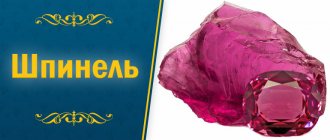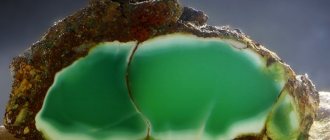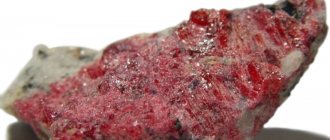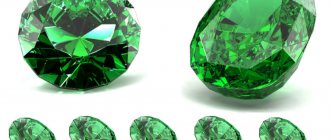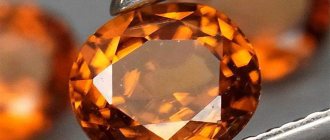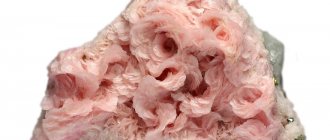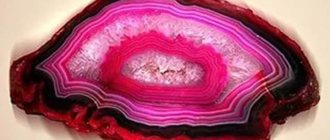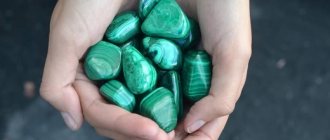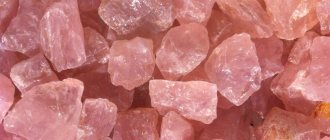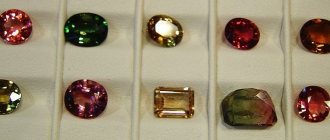All jewelry connoisseurs, when talking about corundum, are primarily interested in whether it is a precious stone or not. Its two varieties are precious - ruby and sapphire. In fact, without specifying the variety, corundum refers to stones with a quality lower than jewelry, which are often refined, as well as synthetic inserts. For the latter, the tag may indicate either “corundum” or “synthetic”. ruby"/"synth. sapphire".
Corundum - what kind of stone is it?
Corundum is crystalline alumina, aluminum oxide.
Its hardness is quite a bit less than that of diamond, the hardest mineral. The shape of the crystals is flat-tabular or resembles a double pyramid, barrel, prism, cube, cone, etc. The stone is found in the rock in the form of grains, individual inclusions, and crystalline groups.
The size of transparent specimens is up to 10 cm , and opaque ones – up to a meter .
Chemical formula - Al2 O3 .
Physical characteristics:
- Color - red, blue, yellow, pink, gray, brown.
- Gloss - glassy, matte.
- Transparency - transparent, opaque.
- Hardness - 9.
- Density - 3.9–4.1 g / cm3 .
- Fragility - fragile.
- Melting point - 2,050°C .
The color of the mineral depends on impurities (iron, chromium, vanadium, titanium, manganese, nickel).
Sapphires are made from titanium, while rubies are made from chromium. Previously, they were considered different minerals, only recently scientists discovered that they were both corundum.
Some stones are irradiated with x-rays (to make the color thicker) or heated (then the shade will be more subtle).
Story
Corundum is a precious stone. Its history goes back thousands of years.
Ancient Egyptian priests and high priests of Judea decorated their robes with sapphires.
In Rus', corundum was discovered in the Middle Ages. They were called yakhonts: ruby - scarlet, and sapphire - azure.
Corundums were brought to Europe a little later - they were brought from India and South Asian countries by merchants.
Precious stones of the scarlet group began to have the meaning of power, greatness, and chosenness. Rubies adorn the Monomakh's cap, and the crown of British monarchs is decorated with the Black Prince ruby.
It is believed that the name “corundum” comes from Sanskrit (the proto-language of India) and means “ruby”.
Old names of corundums are associated with the East:
- purple stones were called “oriental amethysts”;
- leucosapphires - “oriental diamonds”;
- chlorosapphires - “oriental emeralds”.
Place of Birth
The stones are mined from igneous rocks containing small amounts of silica.
Precious stones are found in placers.
Most corundum on the world market comes from the “Asian quadrangle” - Sri Lanka, India, Myanmar, Thailand.
20 times less than sapphire .
The best sapphires are supplied to the world market from Kashmir (India), and rubies - from Mogok (Myanmar).
Other mining locations:
- Tanzania, Australia (rare black and green sapphires are mined in these countries);
- USA;
- Canada;
- Türkiye;
- Norway;
- Greece;
- Kazakhstan;
- Russia (Primorsky and Krasnoyarsk territories, polar Urals).
Varieties of corundum
The most valuable types of mineral are precious stones: sapphires and rubies. They, in turn, also have varieties.
Rubies
Their range of shades ranges from purple to soft pink. Main varieties:
- Siamese. Reddish-brown, purple stones.
- Ceylonese. Specimens are deep purple or lilac.
Sapphires
The color range ranges from slightly lilac to cornflower blue. Sapphires of other colors are called fancy:
- Chlorosapphire is green, reminiscent of an emerald.
- Violet - specimens of deep purple color.
- Padparadscha - stones with a shade of tea rose or yellow, as well as orange.
- Leucosapphire - transparent colorless (white) specimens.
Sometimes there are stones with an asterism effect - star sapphires and rubies (in cabochons, when illuminated, a star of several rays appears).
Other types
These stones are opaque, dark, cloudy:
- Common corundum is gray and granular.
- Emery is gray-black interspersed with hematite and magnetite, granular, sometimes in opaque crystals.
Jewelry value
Varieties of corundum: sapphire and ruby – first-level precious stones:
- The richer the shades of rubies, the more valuable they are.
- Unlike red minerals, the best sapphires are those of medium color saturation, but with a depth of shades.
- A colorless, clear, brightly shiny stone that looks like a diamond, so it is also highly valued.
- The cheapest corundums are brown.
Transparent, rich tones of corundum are often more expensive than their diamond counterparts.
Synthetic corundum
They learned to make artificial corundum a century and a half ago . Currently, it is grown on an industrial scale in Russia, Switzerland, Germany, and the USA.
Synthetic corundum is superior to natural stone in beauty, strength, and functionality.
Artificial specimens are used in industry and jewelry. Almost all jewelry with sapphires and rubies are made with synthetic stones. This is usually indicated on the product tag.
Form of being in nature
The appearance of crystals. The crystals are very common and typical in appearance: dipyramidal, often barrel-shaped, prismatic, less often tabular, sometimes rhombohedral in development.
(1011) twins are usually polysynthetic, appearing as streaking on the basopinacoid; less commonly, intergrowth twins; (0001) twins are rarely observed. Twins at (1011) and (0001) can form under pressure. Often contains inclusions of rutile, hematite, ilmenite, sometimes garnet, spinel, etc. Ilmenite, which has a corundum-type structure and similar crystal lattice parameters, is found in some corundum crystals in certain areas in the form of tiny growths and gives them a blue color. Oriented microscopic growths of rutile cause asterism on the plane of the basopinacoid in the shape of a six-rayed or twelve-rayed star (star sapphires and star rubies). Asterism can also be caused by colloidal matter in oriented capillaries. Hematite in corundum is observed in the form of grains and needles, usually oriented with the c axis parallel to the c axis of the corundum. An oriented growth of diaspore onto corundum crystals was noted. Regular intergrowths of corundum with garnet are known. Intergrowths of corundum with sillimanite, mica, feldspar, and spinel were also noted.
Aggregates. Crystals of various shapes, fine-grained aggregates.
Photo of a large blue crystal
Application
The mineral is used not only in jewelry, but also in other areas. The best samples are used to make jewelry.
Jewelry
Both natural and synthetic corundum are used in this area. They are inserted into jewelry (rings, earrings, bracelets, brooches, pendants).
Assortment for men - cufflinks, rings, tie clips.
Artificial corundums are set in 585-carat gold or 925-carat silver, and natural stones are set in high-carat gold or platinum.
Other areas
Natural raw materials not suitable for jewelry making, as well as synthetic corundum, are used in industry. These materials are used in the manufacture of:
- precision engineering products, radio electronics;
- wristwatch mechanism;
- glass for airplanes, rockets, mobile gadgets;
- thermal insulation;
- abrasive materials.
Needles for record players were made from corundum.
Crystallographic characteristics
syngony L33L23PC.
The class is ditrigonal-scalenohedral.
Crystal structure
Al atoms are located in the octahedral voids of the hexagonal closest packing of O atoms according to the “corundum” motif
- Al atoms fill 2/3 of the octahedral voids). The octahedral layers are superimposed on one another in such a way that there are columns of octahedra elongated along the c axis.
- two filled octahedra alternate with unfilled ones.
It is the only natural modification of alumina. The structure corresponds to artificial α-Al2O3. Among artificial compounds, a number of unstable modifications of Al2O3 have been identified, resulting from heating gibbsite, bayerite and boehmite and representing intermediate products in the transition of trihydrates and boehmite to corundum (α -Al2O3).
Main forms : c (0001), r (1011), n (2243), a (1120) (corresponding to the flat faces of F, according to Hartmann), also z (2241).
Medicinal properties
The use of natural corundum in health improvement should only be in addition to the doctor’s prescriptions.
The healing properties of corundum are considered equally effective if the stone is on a cord, in a piece of jewelry or in a pocket.
The nature of the healing effect depends on the color of the mineral:
- Red corundum. Treats blood vessels and the heart, normalizes blood composition. Improves hormonal levels and metabolism. Good for the endocrine system.
- Green. Protects against colds or eases their progression. Improves the functioning of the gastrointestinal tract.
- Blue. Maintains eye health and is useful in the treatment of eye diseases.
- Yellow orange. They normalize metabolism, improve digestion, and promote rejuvenation of the body.
- Violet. Useful for nervous people and those prone to mood swings. Recommended for neuralgia, vascular diseases, and traumatic brain injuries.
If the jewelry contains corundum of different colors, the impact on the owner is complex, but less strong than the impact of a single crystal.
Healing capabilities of the mineral
The healing stone Corundum has a positive effect on human health. Usually associated with the influence of transparent varieties of Corundum (ruby and sapphire) healing from many diseases that are treated with the help of a crystal of a certain color:
- Has a beneficial effect on the digestive organs, liver and kidneys.
- Relieves back pain caused by osteochondrosis, helps heal joints and spine.
- Blue color has a beneficial effect on healing the organs of vision.
- Red Corundum lowers blood pressure, helps heal diseases of the heart and circulatory system.
- Purple gem has a positive effect on schizophrenia, nightmares, insomnia, depression, and diseases of the nervous system.
Magic properties
Corundum is suitable for people who are purposeful, energetic, strong-willed or those who strive to become such.
Talisman jewelry
The assistance the stone provides to the owner largely depends on the type of jewelry:
- Beads, necklace, bracelet bring peace of mind.
- A brooch, pendant, or pendant helps restless and aggressive people gain emotional stability.
- A ring or ring, when worn constantly, awakens creative abilities and talents in the owner.
It is recommended to wear a ring or ring as a talisman on the middle finger of the right hand.
- Earrings help the housewife to correctly assess her character, achieve spiritual harmony, and make the right decisions.
It is believed that corundum is of particular importance for a person with an active lifestyle or seeking to activate their internal reserves to solve major problems. In this case, the energies of the stone and the owner will act in unison.
For people who are inactive and do not want to disturb the peace of their lives, it is better to choose another stone as a talisman, since corundum will encourage active action.
Stone color
Magical properties also depend on the color of the crystals:
- Blue corundum helps to remain faithful.
- Red is a symbol of love; attracts positive energy and protects from negative energy.
- Green improves emotional mood.
- Purple - calms, eliminates difficult memories.
- The colorless stone helps develop willpower and become purposeful.
A pendant, ring or ring, as well as a rough stone are considered the most effective talismans.
Useful tips
This mineral should be worn only by those people who strive to achieve success in their work. Corundum is stunningly beautiful and becomes a chic addition to any look. Sapphire symbolizes fidelity. It can be presented as a gift to a loved one. The appearance of corundum promotes peace. The scarlet hue, on the contrary, accelerates the pulse and blood circulation.
Minerals of different colors should be used during yoga. Each shade affects a specific chakra and leads to absolute harmony.
Who is suitable according to their zodiac sign?
Many people like corundums, but using them as talismans, amulets, and amulets is recommended only for those whose zodiac sign is compatible with the energy of these stones.
Both ruby and sapphire are ideal for the zodiac signs of the element of Fire (Aries, Sagittarius, Leo) . Influenced by these gemstones:
- Aries will begin to look at life optimistically and will direct its energy to useful things.
- Sagittarius will gain determination, purposefulness, and become more loyal to others.
- Leo will believe in his strength and capabilities. Men will become more masculine and women will become more attractive.
Also, according to the horoscope, the energy of ruby is compatible with the energy of Scorpio, Gemini, Libra , and blue sapphire is compatible with the energy of Aquarius .
Representatives of other zodiac signs can wear corundum only as jewelry.
How to wear
The rules for wearing accessories with natural and synthetic corundum are similar.
Natural and artificial corundum are indistinguishable in appearance, but the latter are affordable for almost everyone.
The combination of this gem is permissible only with stones of equal level. It is incompatible with turquoise, jasper, malachite and similar colored stones.
If you want the stone to stand out first in your jewelry, rather than expensive metal, choose corundum in a silver frame.
It is believed that the older the owner of the jewelry, the larger the inserts should be and the richer their color.
Expensive gems match the appropriate wardrobe: custom-made or branded.
How to care
In order for jewelry made from these stones to look beautiful, they need to be properly cared for.
Caring for natural corundum
They should be handled as follows:
- Wipe jewelry regularly with a damp cloth.
- Clean with mild washing powder (1 teaspoon per glass of water) or a weak solution of ammonia (10–15 drops per glass) .
- You can store it in a box with other jewelry.
- Protect from heat to prevent fading.
- Do not leave for a long time where there is bright light, especially sunny.
- Make sure that the stone insert in the frame sits firmly.
Caring for artificial corundum
Such stones are unpretentious: they are not afraid of elevated temperatures, and they can be cleaned using household chemicals.
How to distinguish from a fake
Imitations of corundum are of the following types:
- artificial stones;
- refined crystals;
- glass.
To distinguish natural stone from fake, different methods are used.
Synthetics
Such specimens can be distinguished from natural corundum only with the help of a magnifying glass, microscope or ultraviolet irradiation:
- Natural pebbles always contain defects and inclusions (air bubbles, microcracks). Flawless natural specimens are sold only at auctions.
- In synthetics, under a microscope, curvilinear zoning is visible - a sign that the crystal grew in the laboratory.
- If a sapphire turns green when exposed to ultraviolet light, this indicates that it is artificial.
- The price also indicates the origin of the stone - specimens of real corundum of jewelry grade are not cheap.
Ennoblement
To make natural very light or faded specimens more attractive, they are “ennobled” by irradiation or heat treatment. You can only check the second method: a tinted pebble becomes lighter when reheated.
Glass
The classic way to identify such a fake is to hold a sample in your hand. Heating up quickly means it's glass.
Main conclusions
Ruby corundum is an artificial analogue of natural stone with an identical crystal lattice structure and a similar chemical composition.
- Like ruby, sapphire corundum is a laboratory-grown mineral.
- You can distinguish artificial analogues from the original by visually examining the structure, heating or irradiating the stone.
- The color of corundum is closely related to its composition, namely to the impurities that are contained in small quantities in the ore.
- The areas of application of the stone include both jewelry and industrial sectors.
- If you wish, you can choose a stone based on your zodiac sign and birth period.
Corundum can be an excellent talisman if you choose the right variety and don’t forget to care for it regularly.
Share your opinion about this amazing mineral and stories about your talismans and amulets with precious and semi-precious stones.
Price
The cost of precious varieties of corundum is high. It is installed after research:
- colors;
- structures;
- weight;
- inclusions;
- cutting;
- mining sites.
Budget jewelry made from corundum costs thousands of rubles . The cost of premium segment products is tens of thousands of rubles .
Artificial stones are inexpensive.
Ruby price
Unrefined rubies of the highest quality are very rare. They are sold mainly at auctions. Jewelry stores sell refined (heated) stones. Such a ruby can be bought for $110 per carat .
Treated rubies, in which the voids have been filled with resin, oil or molten glass, sell for $30 per carat .
Sapphire price
Examples of prices for some types of sapphire:
- Green - from $75 per carat .
- Yellow - 100–120 per carat .
- Padparadscha - 130 per carat .
- Cornflower blue - 300–1000 per carat .
Examples of prices in Russian online stores
In these stores you can buy corundum products at the following prices:
- synthetic ruby (fraction 1–2 mm, package 100 grams) - 86 rub. ;
- natural sapphire (7.5 mm, hole 0.8 mm) - 140 rub. for 1 piece ;
- natural refined sapphire with cut (3–5 mm, pack of 10 pieces) — 500 rub. ;
- natural ruby beads (3–8 mm, set of 5 pieces) — 870 rub. ;
- corundum in rock (230 grams) - 3,850 rubles. ;
- earrings with natural sapphires (925 sterling silver) — RUB 5,780. ;
- ring with leucosapphire (925 sterling silver) — RUB 9,070. ;
- ring with sapphire (0.53 carat; 14k white gold) — RUB 19,990.
Price
The price of a stone depends on a number of its parameters, such as:
- purity;
- weight;
- shade;
- cut.
Category I rubies can cost up to $1,500 per carat. But the cost of the same stones, but category III, will be significantly different and will not exceed $400-500 per unit of weight.
The most expensive rubies are those from Burma. They are sold exclusively at auctions, where the price per carat starts at $3,000.
Sapphires are cheaper, somewhere around $150 per carat. However, the larger the stone, the higher the price per unit weight. Minerals larger than 8-9 carats cost at least 10 thousand dollars on the market.
